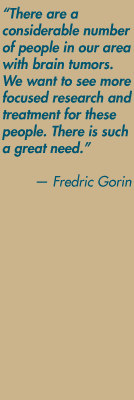Fredric Gorin, a professor of neurology at UC Davis, was looking for a way to control the devastating brain swelling that frequently accompanies a head injury or stroke. Instead, he found a clue to designing new drugs against brain tumors.
The discovery changed the course of Gorin's research and sparked new hope for treating a neurologic cancer, glioblastoma, that kills 95 percent of sufferers within two years.
From published research, Gorin knew that a certain adult brain cancer cell — a malignant glioma cell — has the ability to swell. By determining how these malignant cells take on fluid, he suspected he might gain insights that could be applied to protecting injured cells.
Gorin guessed that the glioma cells relied on surface molecules known as sodiumproton exchangers to regulate their fluid levels. To test his hunch, he performed experiments with Peter Cala, professor and chair of physiology and membrane biology, in which glioma cells were exposed to a commonly used diuretic, amiloride, known to inhibit sodium-proton exchange.
"We accidentally discovered that amiloride, when infused directly into the brains of rats implanted with intracranial human glioblastomas, would kill glioma cells, but not normal brain cells," said Gorin, who works out of the UC Davis Center for Neuroscience.
Toward a new drug
Over the past 10 years, Gorin has labored to turn that serendipitous finding into a safe and effective drug for glioblastoma. Amiloride itself wouldn't work. The diuretic doesn't cross the blood-brain barrier, and can't be administered safely into the human brain at the doses needed to be effective.
So Gorin undertook the systematic study of the cellular mechanisms by which the drug kills brain tumors and slows their growth. Now he and his colleagues are using the information to engineer and test candidate compounds for new "prodrugs" against glioblastoma.
Prodrugs are harmless, inactive compounds that become active drugs only when exposed to an activating substance. Gorin and his colleagues have designed prodrugs that become drugs with amiloride-like properties when they encounter certain enzymes produced by malignant cells. In animal experiments, these prodrugs appear to be much less toxic than amiloride — and more effective at killing specific parts of a brain tumor.
Clinical testing
"With continued laboratory funding, we hope to test our compounds in humans within the next four to five years," Gorin said.
The drug will need to be safe enough for patients to take for many years both to treat glioblastoma and prevent recurrence.
Gorin's work to date has been supported by more than $2 million in grants, including a prestigious multi-year Research Project Grant (RO1) from the National Institute of Neurological Disorders and Stroke and a Specialized Program of Research Excellence (SPORE) grant for the study of brain tumors. The SPORE grant is based at UC San Francisco. Gorin also has received support from the California Cancer Research Coordinating Committee.
Stalking a killer
Patients and their physicians are desperate for a treatment for glioblastoma. The ideal drug would cross the blood-brain barrier and kill cancerous cells without causing debilitating side effects.
"There are not many brain cancer drugs that meet these requirements, which is why this work is so important," said Robert O'Donnell, an associate professor of medicine who collaborates with Gorin.
Brain cancer is the leading cause of cancer-related death for those under age 35. Half of all brain tumors are primary ones, like glioblastoma, that originate in the brain, as opposed to spreading from other parts of the body. Every year, 17,000 Americans are diagnosed with primary brain cancer and 13,000 die of the disease.
Glioblastoma, thought to be caused by a genetic mutation, claimed the lives of composer George Gershwin at age 39 in 1937 and singer Bob Marley at age 36 in 1981.
Gorin credits the collaborative atmosphere at UC Davis with the growing success of his research program. From professors to graduate students and chemists to surgeons, the list of Gorin's collaborators is lengthy and varied. Michael Nantz, for one, was eager to join forces with Gorin.
"His whole concept of targeting these proton exchangers is a very exciting, new approach," said Nantz, a professor of chemistry.
Nantz and his graduate students are busy making the prodrugs that, when activated, mimic amiloride's destructive effect on glioma cells.
Stem-cell theory
Rudolph Schrot, an assistant professor of neurosurgery, is another of Gorin's collaborators. According to Schrot, one of the newest theories of cancer biology holds that cancerous cells may arise directly from stem cells.
So Schrot and Gorin have teamed up with James Angelastro, an assistant professor of molecular biosciences in the School of Veterinary Medicine, in an effort to find and isolate brain tumor stem cells in patients who have died from particularly aggressive, fast-growing tumors. Their goal is to find these stem cells and use them as targets for more novel drugs.
"Brain tumors are not able to be cured by removing them," Schrot said. "The reason may be that stem cells remain after the bulk of these cells has been destroyed."
Gorin and his colleagues have built a comprehensive network of basic and clinical researchers that also includes neurosurgeons James Boggan, Candace Floyd and Bruce Lyeth, pathologist Robert Cardiff, entomologist Bruce Hammock and biochemist Thomas Jue. The UC Davis faculty who make up this network hope to change the way brain cancers are treated and have established a solid base for a growing neuro-oncology research program at UC Davis.
Gorin said he hopes to extend the collaboration to more members of the UC Davis Cancer Center research program and to see new researchers recruited to the campus and medical center who are focused on neuro-oncology.
"There are a considerable number of people in our area with brain tumors," Gorin said. "We want to see more focused research and treatment for these people. There is such a great need."




